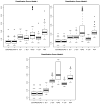QUADRO: A SUPERVISED DIMENSION REDUCTION METHOD VIA RAYLEIGH QUOTIENT OPTIMIZATION
- PMID: 26778864
- PMCID: PMC4712455
- DOI: 10.1214/14-AOS1307
QUADRO: A SUPERVISED DIMENSION REDUCTION METHOD VIA RAYLEIGH QUOTIENT OPTIMIZATION
Abstract
We propose a novel Rayleigh quotient based sparse quadratic dimension reduction method-named QUADRO (Quadratic Dimension Reduction via Rayleigh Optimization)-for analyzing high-dimensional data. Unlike in the linear setting where Rayleigh quotient optimization coincides with classification, these two problems are very different under nonlinear settings. In this paper, we clarify this difference and show that Rayleigh quotient optimization may be of independent scientific interests. One major challenge of Rayleigh quotient optimization is that the variance of quadratic statistics involves all fourth cross-moments of predictors, which are infeasible to compute for high-dimensional applications and may accumulate too many stochastic errors. This issue is resolved by considering a family of elliptical models. Moreover, for heavy-tail distributions, robust estimates of mean vectors and covariance matrices are employed to guarantee uniform convergence in estimating non-polynomially many parameters, even though only the fourth moments are assumed. Methodologically, QUADRO is based on elliptical models which allow us to formulate the Rayleigh quotient maximization as a convex optimization problem. Computationally, we propose an efficient linearized augmented Lagrangian method to solve the constrained optimization problem. Theoretically, we provide explicit rates of convergence in terms of Rayleigh quotient under both Gaussian and general elliptical models. Thorough numerical results on both synthetic and real datasets are also provided to back up our theoretical results.
Keywords: Classification; Rayleigh quotient; dimension reduction; oracle inequality; quadratic discriminant analysis.
Figures





Similar articles
-
Sparse quadratic classification rules via linear dimension reduction.J Multivar Anal. 2019 Jan;169:278-299. doi: 10.1016/j.jmva.2018.09.011. Epub 2018 Oct 3. J Multivar Anal. 2019. PMID: 31105355 Free PMC article.
-
Rayleigh-Rice Mixture Parameter Estimation via EM Algorithm for Change Detection in Multispectral Images.IEEE Trans Image Process. 2015 Dec;24(12):5004-16. doi: 10.1109/TIP.2015.2474710. Epub 2015 Aug 28. IEEE Trans Image Process. 2015. PMID: 26336124
-
A Streaming model for Generalized Rayleigh with extension to Minimum Noise Fraction.Proc IEEE Int Conf Big Data. 2019 Dec;2019:74-83. doi: 10.1109/BigData47090.2019.9006512. Epub 2020 Feb 24. Proc IEEE Int Conf Big Data. 2019. PMID: 32363354 Free PMC article.
-
A rank-one update algorithm for fast solving kernel Foley-Sammon optimal discriminant vectors.IEEE Trans Neural Netw. 2010 Mar;21(3):393-403. doi: 10.1109/TNN.2009.2037149. Epub 2010 Jan 19. IEEE Trans Neural Netw. 2010. PMID: 20089474
-
Scale-Invariant Sparse PCA on High Dimensional Meta-elliptical Data.J Am Stat Assoc. 2014 Jan 1;109(505):275-287. doi: 10.1080/01621459.2013.844699. J Am Stat Assoc. 2014. PMID: 24932056 Free PMC article.
Cited by
-
LARGE COVARIANCE ESTIMATION THROUGH ELLIPTICAL FACTOR MODELS.Ann Stat. 2018 Aug;46(4):1383-1414. doi: 10.1214/17-AOS1588. Epub 2018 Jun 27. Ann Stat. 2018. PMID: 30214095 Free PMC article.
-
Predictive overfitting in immunological applications: Pitfalls and solutions.Hum Vaccin Immunother. 2023 Aug 1;19(2):2251830. doi: 10.1080/21645515.2023.2251830. Hum Vaccin Immunother. 2023. PMID: 37697867 Free PMC article. Review.
-
Environmental factors influencing biological rhythms in newborns: From neonatal intensive care units to home.Sleep Sci. 2016 Oct-Dec;9(4):295-300. doi: 10.1016/j.slsci.2016.10.004. Epub 2017 Jan 7. Sleep Sci. 2016. PMID: 28154744 Free PMC article.
-
Exploring patterns enriched in a dataset with contrastive principal component analysis.Nat Commun. 2018 May 30;9(1):2134. doi: 10.1038/s41467-018-04608-8. Nat Commun. 2018. PMID: 29849030 Free PMC article.
-
Multitask Quantile Regression under the Transnormal Model.J Am Stat Assoc. 2016;111(516):1726-1735. doi: 10.1080/01621459.2015.1113973. Epub 2017 Jan 5. J Am Stat Assoc. 2016. PMID: 29097827 Free PMC article.
References
-
- Bickel PJ, Ritov Y, Tsybakov AB. Simultaneous analysis of lasso and Dantzig selector. Ann Statist. 2009;37:1705–1732. MR2533469.
-
- Cai T, Liu W. A direct estimation approach to sparse linear discriminant analysis. J Amer Statist Assoc. 2011;106:1566–1577. MR2896857.
-
- Cai T, Liu W, Luo X. A constrained ℓ1 minimization approach to sparse precision matrix estimation. J Amer Statist Assoc. 2011;106:594–607. MR2847973.
-
- Catoni O. Challenging the empirical mean and empirical variance: A deviation study. Ann Inst Henri Poincaré Probab Stat. 2012;48:1148–1185. MR3052407.
Grants and funding
LinkOut - more resources
Full Text Sources
